ABOUT CALIFORNIA SEA LIONS
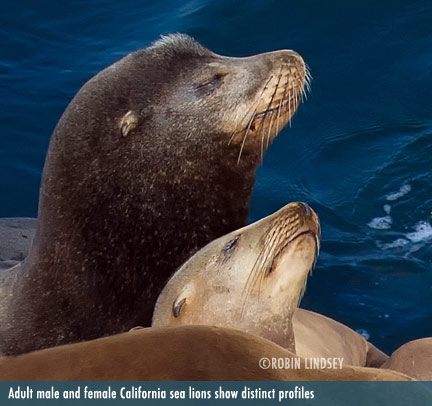 PHYSICAL DESCRIPTION
PHYSICAL DESCRIPTION
Males can reach a size up to 8 feet long and 700-1,000 lbs.
Females are smaller, reaching 6.5 ft long and up to 240 lbs.
Adult males grow a large bump of bone on the top of their heads, known as a sagittal crest, as they reach sexual maturity. Females do not exhibit this, having lower and smaller foreheads. Unlike harbor seals and other true seals, California sea lions have external ear flaps and long, dog-like muzzles.
Males are a chocolate brown, females are tan to golden brown.The coat darkens to almost black when wet. As adult males age, their heads become light tan. Adult females are a lighter golden color. Sea lions molt (shed their hair) every year after breeding season.
Sea lions have sleek torpedo-like bodies and are powerful swimmers.
LIFESPAN 20-30 years
LOCOMOTION Graceful and acrobatic in the water, sea lions propel themselves through the water with large, wing-like fore flippers, usimg their hind flippers and tail for steering. Able to rotate their hind flippers for locomotion on land, sea lions are quite are nimble and can gallop onshore. They have a short tail.
They have no claws on their fore flippers. but use their nails on the back flippers for grooming their coats.
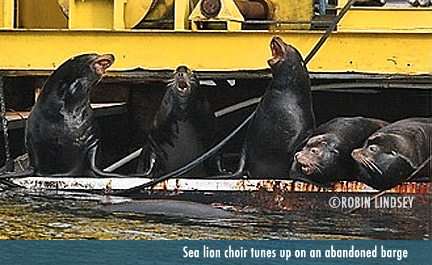 RANGE AND HABITAT The California sea lion resides along the Pacific Coast mainly in the waters of central Mexico and California where they breed, but in non-breeding season can be found as far north as Vancouver Island, Canada. These highly intelligent and social mammals breed in large colonies on offshore island rookeries such as California’s Channel Islands.
RANGE AND HABITAT The California sea lion resides along the Pacific Coast mainly in the waters of central Mexico and California where they breed, but in non-breeding season can be found as far north as Vancouver Island, Canada. These highly intelligent and social mammals breed in large colonies on offshore island rookeries such as California’s Channel Islands.
Once the breeding season is over, they will often gather at marinas and wharves.
It is common to see California sea lions inside Puget Sound and Seattle's Elliott Bay during fall months when salmon have returned to spawn.
DIET AND HUNTING California sea lions feed on more than 50 species of seafood, mainly squid and fish. Even though they have fearsome canine teeth (used primarily to grab fish), sea lions typically swallow their food whole.
MATING AND BREEDING California sea lions breed around May to June. Males and females reach sexual maturity between 4-5 years of age.
Establishing a territory is important to a male’s success in breeding and mating begins approximately three weeks after the females give birth. Postural displays, fighting (often violent) and barking and growling is common during the mating season as males (known as bulls) compete for females (cows). Males assemble a number of females and young into a group called a harem and protect them throughout the breeding season. Mating and birthing takes place in remote rookery locations, safe from humans and predators.
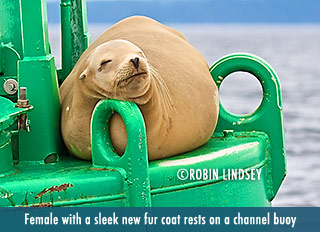 PUPPING The females have gestation period of 11 months and give birth from June to August. Mothers may give birth to a single pup on land or in water. Pups and moms learn to recognize each other’s distinct vocalizations and smell, playing a vital part in the survival of the pup.
PUPPING The females have gestation period of 11 months and give birth from June to August. Mothers may give birth to a single pup on land or in water. Pups and moms learn to recognize each other’s distinct vocalizations and smell, playing a vital part in the survival of the pup.
Pups nurse for six months to a year even though they can digest food at three months of age. Pups learn to swim and hunt at about two months and play together onshore. They leave their mother after a year.
BEHAVIOR After the breeding season, female California sea lions normally stay in southern waters while the adult males and juveniles generally migrate north to feeding sites for the winter. Males use raucous vocalization (loud barking, grunts and growls) and posturing movement as they battle for dominance and territory. Non-breeding groups are gregarious and haul out together in groups called colonies.
Winter haul-outs are often in more exposed locations. Most sea lions found on man-made structures such as piers, platforms and docks are males or juveniles. Sea lions are often seen on navigational buoys, resting and warming up.
 PHYSICAL DESCRIPTION
PHYSICAL DESCRIPTION Males can reach a size up to 8 feet long and 700-1,000 lbs.
Females are smaller, reaching 6.5 ft long and up to 240 lbs.
Adult males grow a large bump of bone on the top of their heads, known as a sagittal crest, as they reach sexual maturity. Females do not exhibit this, having lower and smaller foreheads. Unlike harbor seals and other true seals, California sea lions have external ear flaps and long, dog-like muzzles.
Males are a chocolate brown, females are tan to golden brown.The coat darkens to almost black when wet. As adult males age, their heads become light tan. Adult females are a lighter golden color. Sea lions molt (shed their hair) every year after breeding season.
Sea lions have sleek torpedo-like bodies and are powerful swimmers.
LIFESPAN 20-30 years
LOCOMOTION Graceful and acrobatic in the water, sea lions propel themselves through the water with large, wing-like fore flippers, usimg their hind flippers and tail for steering. Able to rotate their hind flippers for locomotion on land, sea lions are quite are nimble and can gallop onshore. They have a short tail.
They have no claws on their fore flippers. but use their nails on the back flippers for grooming their coats.

Once the breeding season is over, they will often gather at marinas and wharves.
It is common to see California sea lions inside Puget Sound and Seattle's Elliott Bay during fall months when salmon have returned to spawn.
DIET AND HUNTING California sea lions feed on more than 50 species of seafood, mainly squid and fish. Even though they have fearsome canine teeth (used primarily to grab fish), sea lions typically swallow their food whole.
MATING AND BREEDING California sea lions breed around May to June. Males and females reach sexual maturity between 4-5 years of age.
Establishing a territory is important to a male’s success in breeding and mating begins approximately three weeks after the females give birth. Postural displays, fighting (often violent) and barking and growling is common during the mating season as males (known as bulls) compete for females (cows). Males assemble a number of females and young into a group called a harem and protect them throughout the breeding season. Mating and birthing takes place in remote rookery locations, safe from humans and predators.

Pups nurse for six months to a year even though they can digest food at three months of age. Pups learn to swim and hunt at about two months and play together onshore. They leave their mother after a year.
BEHAVIOR After the breeding season, female California sea lions normally stay in southern waters while the adult males and juveniles generally migrate north to feeding sites for the winter. Males use raucous vocalization (loud barking, grunts and growls) and posturing movement as they battle for dominance and territory. Non-breeding groups are gregarious and haul out together in groups called colonies.
Winter haul-outs are often in more exposed locations. Most sea lions found on man-made structures such as piers, platforms and docks are males or juveniles. Sea lions are often seen on navigational buoys, resting and warming up.
Sailing is a behavior sea lions use to warm up or cool down in the water by resting with only flippers and nose visible above the water. This is called thermoregulation. When a number of sea lions cluster together to rest or sleep, it is known as rafting. Typically this will occur in areas where there is no suitable haul-out. The Marine Mammal Stranding Network receives many calls from by concerned onlookers about "entangled" sea lions, when truly the animals are just warming up.
California sea lions can dive up to 600 feet and stay submerged for 40 minutes. Their ears and nostrils close when diving under water.
California sea lions can dive up to 600 feet and stay submerged for 40 minutes. Their ears and nostrils close when diving under water.
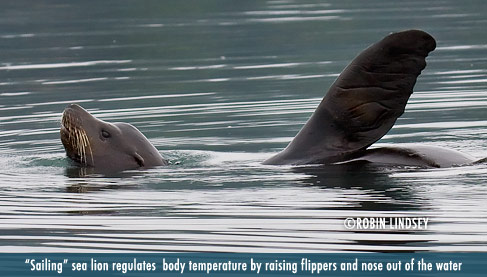
The fastest swimmers of all pinnipeds, they can reach speeds of up to 30 mph. They often leap out of the water in a behavior called porpoising.
For video of sea lion behavior, watch Marine Mammals Two by Two.
For video of sea lion behavior, watch Marine Mammals Two by Two.
SENSES A California sea lion’s hearing is acute on both land and underwater and they are quite vocal. Their vocalizations are much more active onshore and are critical in pups and mothers identifying and locating each other’s unique acoustical voice. They have excellent vision both above and under water and it is believed they are able to discern colors. Sea lions have a highly developed sense of smell above water which is used to identify pups. Their whiskers (vibrassae) are used to detect the vibrations of prey. Sea lions are very gregarious and often pile on top of one another at haul outs.
PREDATORS The only natural predators of the sea lion are killer whales and great white sharks.
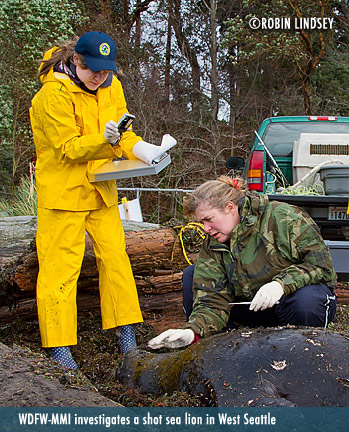 HUMAN IMPACT Fishery interaction is a constant threat to sea lions and all marine mammals. Sea lions become entangled in nets and drown. Fishing line and barbed hooks can cause grave injuries, often leading to death. Disentanglement of pinnipeds is challenging - watch as a Vancouver Aquarium team works to remove fishing gear from sea lions in Canada.
HUMAN IMPACT Fishery interaction is a constant threat to sea lions and all marine mammals. Sea lions become entangled in nets and drown. Fishing line and barbed hooks can cause grave injuries, often leading to death. Disentanglement of pinnipeds is challenging - watch as a Vancouver Aquarium team works to remove fishing gear from sea lions in Canada.
Opportunistic feeders, sea lions are sometimes shot by fishermen if they raid nets or grab fish off the end of a line. Sea lions are scapegoated for dwindling fish stocks caused by overfishing, habitat destruction and pollution. Knowledgeable fishermen know seals and sea lions are an integral part of a complex ecosystem.
Hydroelectric dams and locks create a dangerous environment for sea lions who feed on easy prey which gather at the base of such immense structures. A no-win situation for both fish and marine mammals, read about the Bonneville Dam here.
Pollution poses a tremendous risk for all marine mammals. In recent years, cancer is killing an alarming number of California sea lions. Scientists are trying to determine whether the cause is due to pollution. Some research points to high levels of PCB's present in sea lions with cancerous lesions.
ENVIRONMENTAL IMPACT: SEA LION CRISIS
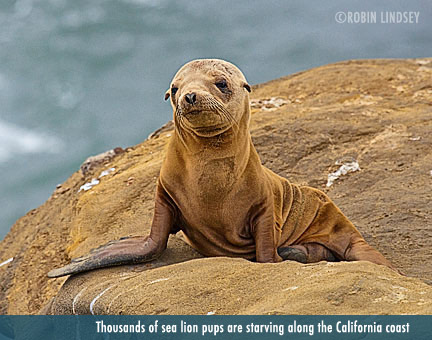 Over the past few years, marine mammal stranding networks and rehabilitation facilities in California have been working in crisis mode. Thousands of scrawny sea lion pups and yearlings have shown up on shore - alone, weak and emaciated.
Over the past few years, marine mammal stranding networks and rehabilitation facilities in California have been working in crisis mode. Thousands of scrawny sea lion pups and yearlings have shown up on shore - alone, weak and emaciated.
And things just continue to get worse. In fact, from January - May of 2015, stranding networks reported 3,340 sick or dead pups. The numbers are simply staggering - over 10 times the average stranding level for the same 5 month period during 2004-2012. Read NOAA's fact sheet about the strandings.
Scientists have been scrambling to figure out why and veterinary teams are overwhelmed, struggling to save as many animals as they can. All the while, more animals strand daily. So many sea lion pups have stranded since 2013, that NOAA has declared an unusual mortality event in California.
What is the reason? According to scientists, it's most likely that rising water temperatures due to an El Niño weather pattern in the Pacific caused sardine and anchovy populations to move further offshore, seeking colder waters. This small, energy-rich forage fish makes up a substantial part of sea lions' diet along the coast of Central and Southern California. Nursing sea lion females depend on prey that's close to shore - and their pups. Sardines usually are. To make things worse, sardine populations have been crashing due to a number of factors, including overfishing.
Sea lion pups are completely dependent on their moms for the first 6 months and are not usually completely weaned until almost a year old. This means that moms are having to travel further for food, leaving pups for longer periods between feeding. If the females are unable to find enough food, they will not produce adequate milk to nurse their pup. It is theorized that hungry pups, left alone too long, may try to hunt on their own - even though they do not have the strength or skills - and are consequently starving.
Related news stories about sea lion crisis in California on Breaking News page.
PREDATORS The only natural predators of the sea lion are killer whales and great white sharks.

Opportunistic feeders, sea lions are sometimes shot by fishermen if they raid nets or grab fish off the end of a line. Sea lions are scapegoated for dwindling fish stocks caused by overfishing, habitat destruction and pollution. Knowledgeable fishermen know seals and sea lions are an integral part of a complex ecosystem.
Hydroelectric dams and locks create a dangerous environment for sea lions who feed on easy prey which gather at the base of such immense structures. A no-win situation for both fish and marine mammals, read about the Bonneville Dam here.
Pollution poses a tremendous risk for all marine mammals. In recent years, cancer is killing an alarming number of California sea lions. Scientists are trying to determine whether the cause is due to pollution. Some research points to high levels of PCB's present in sea lions with cancerous lesions.
ENVIRONMENTAL IMPACT: SEA LION CRISIS

And things just continue to get worse. In fact, from January - May of 2015, stranding networks reported 3,340 sick or dead pups. The numbers are simply staggering - over 10 times the average stranding level for the same 5 month period during 2004-2012. Read NOAA's fact sheet about the strandings.
Scientists have been scrambling to figure out why and veterinary teams are overwhelmed, struggling to save as many animals as they can. All the while, more animals strand daily. So many sea lion pups have stranded since 2013, that NOAA has declared an unusual mortality event in California.
What is the reason? According to scientists, it's most likely that rising water temperatures due to an El Niño weather pattern in the Pacific caused sardine and anchovy populations to move further offshore, seeking colder waters. This small, energy-rich forage fish makes up a substantial part of sea lions' diet along the coast of Central and Southern California. Nursing sea lion females depend on prey that's close to shore - and their pups. Sardines usually are. To make things worse, sardine populations have been crashing due to a number of factors, including overfishing.
Sea lion pups are completely dependent on their moms for the first 6 months and are not usually completely weaned until almost a year old. This means that moms are having to travel further for food, leaving pups for longer periods between feeding. If the females are unable to find enough food, they will not produce adequate milk to nurse their pup. It is theorized that hungry pups, left alone too long, may try to hunt on their own - even though they do not have the strength or skills - and are consequently starving.
Related news stories about sea lion crisis in California on Breaking News page.